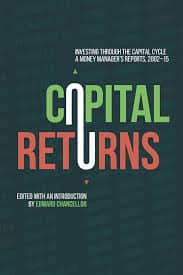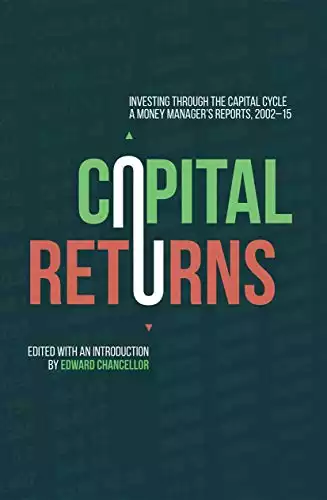Overview : Capital Returns By Edward Chancellor
-
Book Title: Capital Returns
-
Author: Edward Chancellor
-
Publication Date: September 2015
-
Rating: 4.5
-
price: $18.65
-
Pages: 368
Author Information
Edward Chancellor is a financial historian, journalist, and investment strategist. He has written for the Financial Times and served as a member of GMO's asset allocation team. Chancellor's expertise in financial history and market dynamics lends credibility to the insights presented in "Capital Returns."
Introduction to Capital Returns Book
In the ever-evolving world of finance and investing, Edward Chancellor's "Capital Returns: Investing Through the Capital Cycle" stands out as a beacon of fresh perspective. This comprehensive review delves into the intricacies of Chancellor's work, exploring its unique approach to understanding market dynamics and its potential to revolutionize investment strategies.
Capital Returns Book Summary
"Capital Returns" is a compilation of insights from Marathon Asset Management, expertly curated and contextualized by Edward Chancellor. The book introduces readers to the capital cycle approach, a paradigm that shifts focus from traditional financial metrics to the broader patterns of capital allocation within industries. This perspective offers a novel way to anticipate market trends and make informed investment decisions.
Chancellor argues that understanding the flow of capital into and out of industries is crucial for predicting long-term investment returns. The book posits that when capital is abundant in a sector, it often leads to overcapacity and diminished returns. Conversely, capital scarcity can result in industry consolidation and improved profitability for surviving firms.
Analysis of Themes
The Capital Cycle Theory
At its core, the capital cycle theory challenges conventional wisdom in financial analysis. While many investors focus on short-term earnings and P/E ratios, Chancellor advocates for a more holistic view that considers the cyclical nature of capital flows. This approach encourages investors to look beyond immediate market conditions and consider long-term industry trends.
Behavioral Economics in Investing
One of the book's strengths is its integration of behavioral economics into the capital cycle framework. Chancellor explores how psychological factors can exacerbate market cycles, leading to periods of irrational exuberance or unwarranted pessimism. By understanding these behavioral tendencies, investors can better position themselves to capitalize on market inefficiencies.
Practical Application of the Capital Cycle Approach
The book doesn't just present theory; it offers practical guidance for implementing the capital cycle approach in real-world investing scenarios. Through case studies and examples, readers learn how to identify industries at different stages of the capital cycle and make informed investment decisions based on these insights.
Writing Style
Chancellor's writing is clear, concise, and accessible to both seasoned investors and those new to financial literature. He skillfully weaves together complex economic concepts with real-world examples, making the material engaging and easy to digest. The use of Marathon Asset Management's memos adds credibility and practical context to the theoretical framework presented.
Strengths and Weaknesses of Capital Returns Book
Strengths:
- Offers a unique perspective on market dynamics
- Integrates behavioral economics into investment analysis
- Provides practical examples and case studies
- Challenges conventional investment wisdom
Weaknesses:
- May be less applicable for short-term traders
- Requires a broad understanding of macroeconomic trends
- Could benefit from more discussion on emerging market trends and cryptocurrencies
Capital Returns Related Books
While "Capital Returns" shares some similarities with value investing classics like Benjamin Graham's "The Intelligent Investor," it offers a unique macro-level perspective. Compared to works like Michael Porter's "Competitive Strategy," Chancellor's book provides a more dynamic view of industry evolution through the lens of capital flows.
In the context of modern finance literature, "Capital Returns" aligns well with books that emphasize long-term thinking and behavioral finance, such as Daniel Kahneman's "Thinking, Fast and Slow" and Howard Marks' "The Most Important Thing."
Key Quotes
"The capital cycle approach to investing differs from traditional financial analysis, which often focuses on short-term earnings and 'catalyst' events."
"Investors who understand the capital cycle can profit from observing the ebb and flow of capital into and out of industries."
Highlights from Capital Return Book
Capital Cycle Insight: Investment returns are influenced by the flow of capital in and out of industries over time.
Supply and Demand Dynamics: Industries attract capital in profitable times, leading to overcapacity and lower returns when supply exceeds demand.
Contrarian Investment: Profits are found by investing in under-capitalized sectors and avoiding over-supplied ones.
Competitive Advantage: Firms that resist excess capital expansion maintain stronger, more sustainable returns.
Investor Patience: Success requires patience and awareness of cycles, rather than reacting to short-term market trends.
Capital Discipline: Effective investment strategies focus on companies with disciplined capital management, avoiding industries facing overinvestment.
Conclusion
"Capital Returns: Investing Through the Capital Cycle" is a must-read for investors seeking to deepen their understanding of market dynamics and improve their long-term investment strategies. By emphasizing the importance of capital flows and industry cycles, Chancellor provides readers with a powerful framework for navigating complex financial markets.
In an era of rapid technological change and evolving market trends, the principles outlined in this book remain highly relevant. Whether you're interested in traditional markets or exploring new frontiers like cryptocurrencies, the capital cycle approach offers valuable insights for making informed investment decisions.
For those looking to apply these concepts to their own investment strategy, "Capital Returns" is an invaluable resource.
Click here to purchase the book and start your journey towards more insightful investing. By understanding the capital cycle, you'll be better equipped to identify opportunities, manage risks, and achieve long-term financial success in today's dynamic market environment. In conclusion, this article has provided an overview of the topic at hand.





